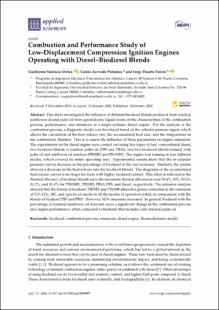Combustion and performance study of low-displacement compression ignition engines operating with Diesel–Biodiesel blends
Artículo de revista
2020-01-30
Applied Sciences
Suiza
This study investigated the influence of different biodiesel blends produced from residual sunflower oil and palm oil from agroindustry liquid waste on the characteristics of the combustion process, performance, and emissions in a single-cylinder diesel engine. For the analysis of the combustion process, a diagnostic model was developed based on the cylinder pressure signal, which allows the calculation of the heat release rate, the accumulated heat rate, and the temperature in the combustion chamber. This is to assess the influence of these parameters on engine emissions. The experiments on the diesel engine were carried out using five types of fuel: conventional diesel, two biodiesel blends of residual palm oil (PB5 and PB10), and two biodiesel blends formed with palm oil and sunflower oil residues (PB5SB5 and PB10SB5). The engine was running in four different modes, which covered its entire operating area. Experimental results show that the in-cylinder pressure curves decrease as the percentage of biodiesel in the fuel increases. Similarly, the results showed a decrease in the heat release rate for biodiesel blends. The diagrams of the accumulated heat release curves were larger for fuels with higher biodiesel content. This effect is reflected in the thermal efficiency of biodiesel blends since the maximum thermal efficiencies were 29.4%, 30%, 30.6%, 31.2%, and 31.8% for PB10SB5, PB5SB5, PB10, PB5, and diesel, respectively. The emission analysis showed that the blends of biodiesel PB5SB5 and PB10SB allowed a greater reduction in the emissions of CO, CO2, HC, and opacity of smoke in all the modes of operation tested, in comparison with the blends of biodiesel PB5 and PB10. However, NOx emissions increased. In general, biodiesel with the percentage of residual sunflower oil does not cause a significant change in the combustion process and engine performance, when compared to biodiesel that includes only residual palm oil.
Descripción:
Combustion and Performance Study of Low-Displacement Compression Ignition Engines Operating with Diesel–Biodiesel Blends.pdf
Título: Combustion and Performance Study of Low-Displacement Compression Ignition Engines Operating with Diesel–Biodiesel Blends.pdf
Tamaño: 8.069Mb
 PDF
PDF
 LEER EN FLIP
LEER EN FLIP
Título: Combustion and Performance Study of Low-Displacement Compression Ignition Engines Operating with Diesel–Biodiesel Blends.pdf
Tamaño: 8.069Mb
 PDF
PDF
 LEER EN FLIP
LEER EN FLIP
















